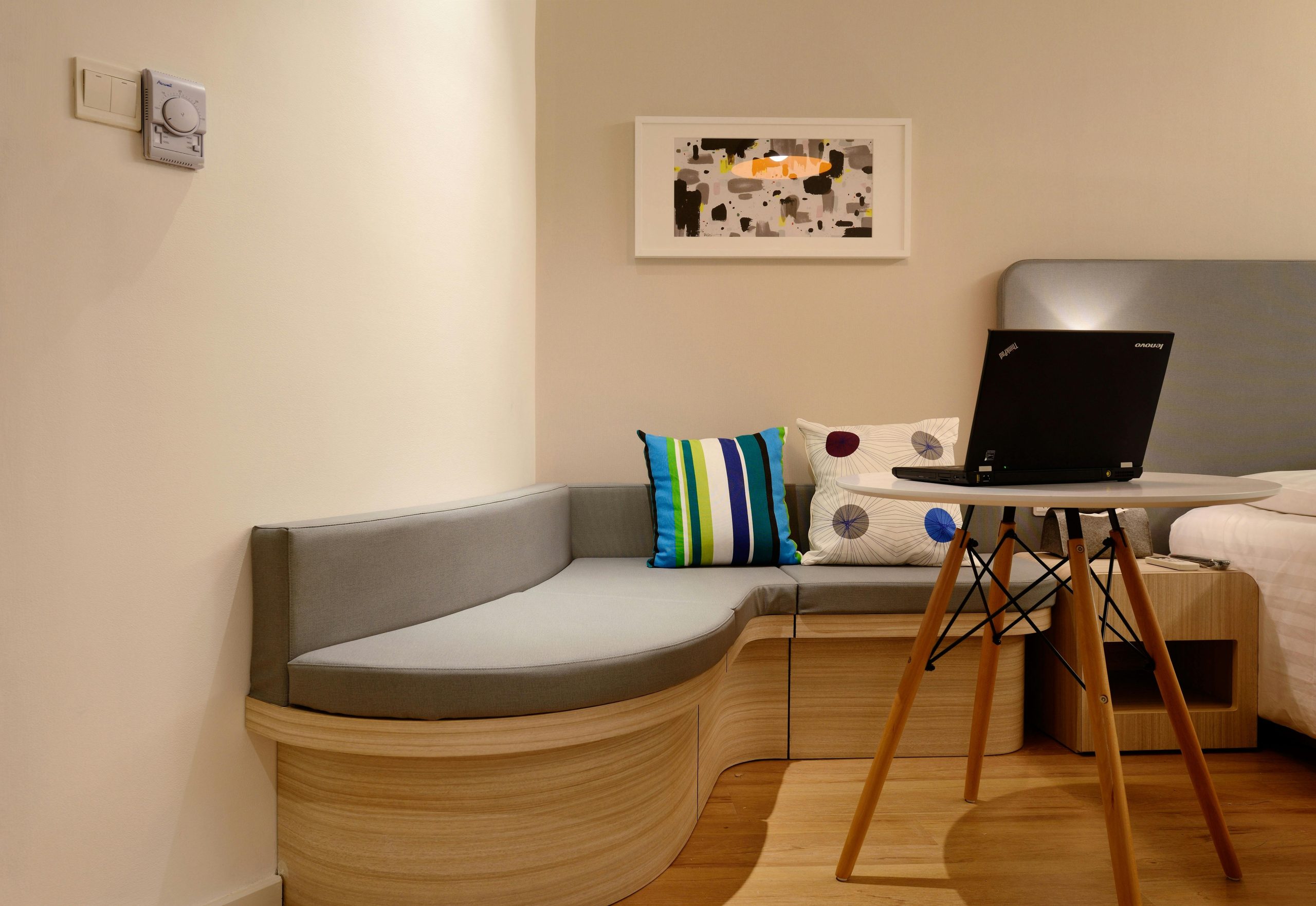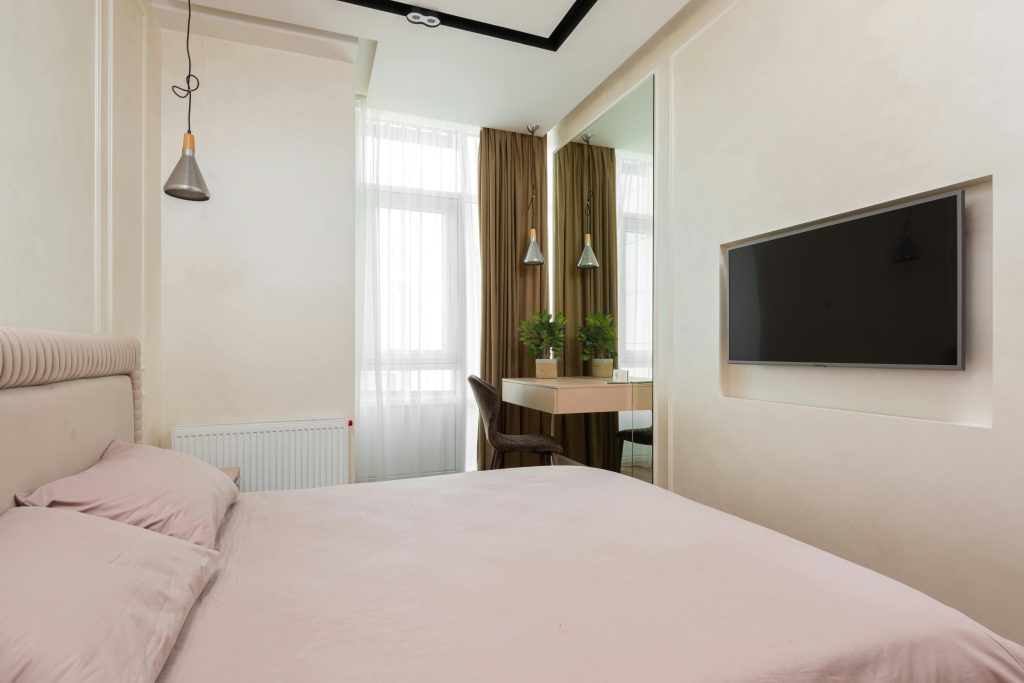Decorating a small space can be challenging, but it’s also an opportunity to get creative and maximize every square inch. Whether you live in a compact apartment, studio, or simply a cozy room, strategic choices in furniture, décor, and color can make your space feel open, organized, and stylish. Here’s a comprehensive guide on how to decorate a small space without breaking the bank.
1. Use Light Colors & Mirrors

Color plays a major role in how spacious a room feels. Lighter hues reflect light, making walls feel farther apart and ceilings higher.
Tips for Using Color and Mirrors:
- Light Wall Colors: Whites, creams, pastels, and soft grays visually expand the room. Dark colors can make a space feel more enclosed.
- Reflective Surfaces: Incorporate mirrors or glossy surfaces to bounce light around the room. A large wall mirror can double the perceived size of a room.
- Ceiling Tricks: Painting the ceiling a slightly lighter shade than the walls adds height. Consider vertical stripes on walls for extra visual lift.
- Mirrored Furniture: Coffee tables, dressers, or nightstands with mirrored surfaces reflect light and reduce visual clutter.
Using mirrors and light colors is a foundational step when trying to make a small room look bigger.
2. Maintain a Clean, Organized Space
Even the most stylish décor can feel cramped if clutter dominates. Regular cleaning and organization are essential for maximizing space and comfort.
Organization Tips:
- Daily Tidying: Put items away immediately after use to prevent accumulation of clutter.
- Declutter Regularly: Remove unnecessary furniture, décor, or items that don’t serve a purpose.
- Use Storage Bins: Group small items into baskets, bins, or boxes to keep them out of sight.
- Adopt a Routine: Schedule weekly organization sessions to prevent clutter from piling up.
A well-organized space feels larger, cleaner, and more functional.
3. Add Vertical Elements
Drawing the eye upward can enhance the perception of height, making small rooms feel more spacious.
Vertical Design Ideas:
- Tall Shelves or Bookcases: Utilize vertical storage to free up floor space while drawing attention upward.
- Vertical Stripes: Paint or wallpaper in vertical patterns to elongate walls visually.
- Hanging Plants: Decorate vertically with plants or artwork instead of cluttering floor space.
- Wall Hooks & Racks: Use vertical storage solutions to hold coats, bags, or accessories efficiently.
Vertical elements are a simple and affordable way to create the illusion of a larger, more open space.
4. Choose Minimalist Décor
In a small room, every item counts. Adopting a minimalist approach keeps the space from feeling overcrowded while allowing key décor elements to shine.
Décor Tips:
- Limit Accessories: Opt for a few statement pieces rather than filling surfaces with many small items.
- Vertical Décor: Hang art or shelves vertically to draw the eye upward.
- Consistent Style: Stick to a cohesive design theme to reduce visual noise.
- Hidden Cables: Conceal wires from electronics for a cleaner look.
- Multipurpose Pieces: Use décor that doubles as storage, like ottomans with lids or decorative baskets.
Minimalism in décor enhances a room’s flow and maximizes both style and functionality.
5. Incorporate Multi-Functional Furniture

Furniture that serves multiple purposes is essential for small spaces, helping you save room while maintaining comfort and style.
Multi-Functional Furniture Ideas:
- Sofa Beds or Daybeds: Perfect for living rooms or studios that double as guest areas.
- Storage Ottomans: Provide seating and hidden storage in one piece.
- Foldable Tables and Desks: Ideal for work or dining spaces that need flexibility.
- Nesting Tables: Allow for extra surface area when needed but can be tucked away easily.
Investing in multi-functional furniture ensures the space remains uncluttered and versatile.
6. Utilize Lighting Wisely
Proper lighting can transform a small space, making it feel larger, brighter, and more inviting.
Lighting Tips:
- Layered Lighting: Combine ambient, task, and accent lighting to create depth.
- Natural Light: Keep windows unobstructed to let sunlight fill the room.
- Wall-Mounted Fixtures: Use sconces instead of table lamps to free up floor and table space.
- Reflective Surfaces: Mirrors and light-colored décor enhance lighting impact.
Bright, well-placed lighting visually opens up the room and enhances décor elements.
7. Use Rugs Strategically
Rugs can define areas in a small space and create the illusion of larger zones.
Rug Tips:
- Consistent Color Palette: Keep rugs in light or neutral tones to avoid breaking up the space.
- Large Rugs: One large rug covering the main area can make a room feel unified and bigger.
- Layering: Light, thin rugs over a neutral base can add texture without reducing visual space.
A well-chosen rug anchors furniture and improves flow in small spaces.
8. Add Mirrors & Reflective Surfaces
Mirrors are one of the most effective tricks for making small spaces feel larger. Reflective surfaces also add brightness and depth.
Mirror Ideas:
- Full-Length Mirrors: Create vertical lines that extend the room.
- Mirrored Furniture: Tables, cabinets, or decorative objects reflect light.
- Gallery Wall of Mirrors: Smaller mirrors arranged in a pattern add visual interest and depth.
Strategically placed mirrors enhance the illusion of space without any structural changes.
9. Personalize Without Cluttering
Small spaces can still reflect your personality without feeling crowded. The key is to prioritize items that bring joy or serve a purpose.
Personalization Tips:
- Statement Pieces: Choose a few impactful decorations, like framed photos or art, instead of many small items.
- Functional Décor: Items like decorative storage boxes, trays, or baskets serve a purpose while adding style.
- Plants: Small indoor plants add color and life without taking up much room.
Personalized, purposeful décor keeps the space warm and inviting while maintaining openness.
10. Maintain Flexibility & Adaptability
Small spaces often require change and adjustment as your lifestyle evolves. Be ready to adapt furniture, layout, and décor.
Flexibility Tips:
- Modular Furniture: Pieces that can be reconfigured to meet different needs.
- Seasonal Swaps: Rotate décor items to keep the space fresh and functional.
- Open Floor Plan: Avoid fixed partitions that limit flexibility and flow.
Adapting your space to your needs ensures it remains functional, comfortable, and visually spacious.
Extra Tips for Decorating a Small Space
Small spaces benefit from thoughtful, creative strategies that maximize style and functionality. Here are additional tips you can implement:
- Floating Furniture: Use wall-mounted desks, shelves, or nightstands to free up floor space and create a lighter, more open feel.
- Multipurpose Pieces: Choose furniture that serves multiple functions, such as a bed with storage drawers, a sofa bed, or a coffee table with hidden compartments.
- Curtain Tricks: Hang curtains closer to the ceiling and let them fall to the floor to make windows appear taller and the room feel more spacious.
- Rugs to Define Space: Use area rugs to separate zones within a room. A well-placed rug can make a seating area feel distinct without adding physical barriers.
- Consistent Color Palette: Stick to a limited set of complementary colors for walls, furniture, and accessories. Consistency creates a cohesive, airy look.
- Reflective Accessories: Incorporate metallic, glass, or mirrored décor items, such as vases, picture frames, or lamp bases, to subtly bounce light and add depth.
- Wall-Mounted Storage: Utilize pegboards, hooks, or magnetic boards for items like kitchen tools, office supplies, or craft materials. Keeping things off the floor instantly opens up space.
- Rotate Décor Seasonally: Switch out smaller accessories seasonally to refresh the room’s look without overcrowding it. This keeps your space feeling lively and organized.
- Greenery Strategically Placed: Use small hanging planters or vertical wall gardens instead of large pots that take up floor space. Plants add vibrancy without clutter.
- Smart Lighting: Use LED strip lights under shelves or along walls to highlight features and add a sense of depth. Layering lighting in unconventional ways can make a small room feel larger and more dynamic.
Final Thoughts
Decorating a small space requires planning, creativity, and smart design choices. By using light colors, mirrors, multi-functional furniture, and strategic décor, you can make even the smallest room feel larger, brighter, and more welcoming. Remember, clutter and poor organization can undermine your efforts, so maintaining a clean, minimalist environment is key.
Whether you’re working with a studio apartment, a tiny bedroom, or a compact living area, these tips can help you transform your small space into a stylish, functional haven. Using these strategies, you’ll master how to make a small room look bigger while keeping your home cozy and visually appealing.
